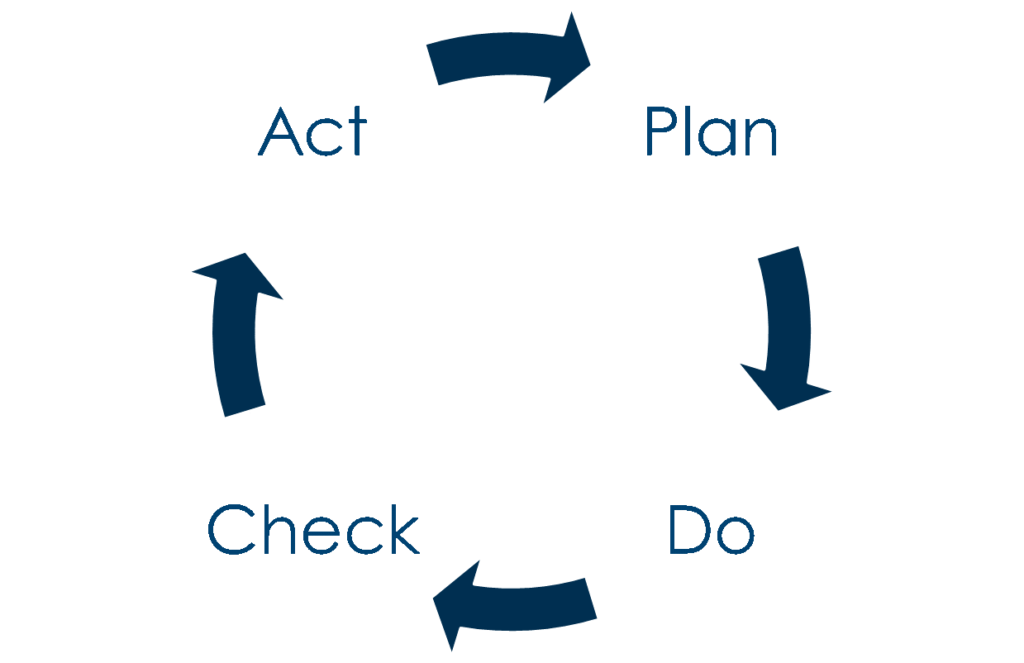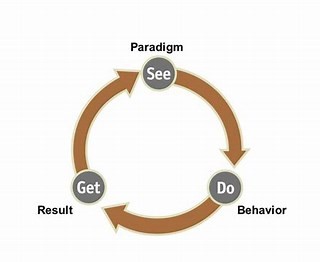Business Operations – Adopting new paradigms will transform your results
A whole new management model unleashes enormous potential to increase your company´s competitiveness – if you look at your business and your people differently!
Authors: Fred Keßler, M.BC.; Gilles Fiorio
Impulse
“Insanity is doing the same things all over and over again but expecting different results.” Albert Einstein. “Planning” always preceded “Doing”, always preceded “Checking”, always preceded “Acting”. The so called PDCA-Cycle, commonly agreed upon to be created and defined by William Edwards Deming (1900-1993), limits the thinking and the performance of corporate leaders all around the globe while giving them the illusion of comfort and security.
Having acquired tough skills in planning, it is easy for leaders to create business cases, budgets and roadmaps for the next fiscal year and calculate them down to the smallest unit in their local currency. Anyway, as soon as it comes to the doing of the plans, everybody loses control because the underlying processes are either not defined or simply a mess – often with one exception: The production process. When checking the achievements, the concerns grow because there are always big gaps between the objectives and the results without a clue where this comes from. Rather than being able to get to the source of the problem in the execution, the blame is put on planning and unexpected events. Finally, everybody only acts on something – but too often merely upon the planning approach.
After all, this led to the perception that the past is of simply no value, and everything needs to be done from scratch – The birth hour of Zero-Based Budgeting.
Introduction
In the last two articles, we introduced the idea to have a closer look at your data and make a fair judgement if you could really trust them. We also stated that the best way to create reliable and permanent data to feed your analyses was to define and automate good processes and create good workflows.

Good workflows are a guarantee that the best practices are applied in the company and they are the foundation for running controlling. It should be remembered, however, that the PDCA cycle was initially created by Deming to help solving problems/misalignments and not to serve as a management model. Nevertheless, this is how it is too often used these days and with too much strict alignment! Many leaders are trying to solve the problem of operationalisation by reducing it to a single dimension: strengthening alignment upstream and downstream the chain of command. When execution gets stuck, managers turn to the tools they know best and respond by further strengthening alignment and by monitoring performance indicators, ending up with micromanagement by scheduling more meetings to monitor progress and recommending actions. As a result, companies fall into a vicious circle where the reinforcement of the alignment to PDCA is rather damaging the results.
Changing the underlying paradigm is key to unleashing so much greater results.
Insight
Alignment with planning could be useful as a fair guideline for execution. Nevertheless, considering it as the only way to ensure a proper execution is to ignore that coordination and agility are needed in unstable markets. No Gantt chart nor plan can withstand the reality or anticipate all the events likely to impact on a company. Again, it is fundamental to look behind the scenes.

This time we start with paradigms. The word “paradigm” stems from the Greek word “paradigma” meaning pattern or sample. It is the way we see the world, influenced by our believes, culture, education, experiences, religion, etc.
The way we see the world determines our behaviour which ultimately determines the results that we achieve.
It is the first thing that leadership lessons will tell you: If you want to change your results on a short term basis, then you should change your behaviour (the way you do the things) but, if you want to make big quantum leap improvements and achieve greater results, then you need to change your paradigms (the way you see the things).
Besides the paradigm that PDCA is the right way to run the business, underlying paradigm to look at people is called “resource view”. Employees are seen as tools to achieve personal/corporate results.
Finally, when facing the enormous gaps between plans and results, leaders often struggle with decisions about improvements. Which behaviour needs to be reinforced and what should be tackled? In some organizations the hire & fire game is seen as the only remedy, creating fear and toxic environments.
In extremely dynamic business environments with rapid technological evolutions, companies do not only need new products and services but also need to innovate their innermost “clockwork” – their processes and their culture.
Just what is a culture? Culture is circumscribed in the literature with “The way we handle things here”.
When middle managers and employees find creative solutions to unforeseen problems or take advantage of unexpected opportunities while ensuring ongoing coordination with other parts of the company, they do not hinder the systematic implementation of the plan, in contrast, they ensure its optimal execution by defining a smart way the things are handled here – thus contributing to a positive culture.
For this reason, leaders must encourage their co-working individuals and their teams to discover and share innovations to improve the robustness of operations without fear. At each level, managers and employees must adapt to the reality of their field, overcome unforeseen obstacles and exploit the opportunities that arise. Front-line employees often have valuable information that is usually and unfortunately neither transmitted, nor captured or exploited.
At this point you might want to remind us that many methods already exist that encourage, collect and extend local initiatives and horizontal or vertical coordination. However, all of them are applying the same old paradigm when building the roadmap by starting with planning rather than with observation or analysis fed by innovation! The DMAIC (Define, Measure, Analyze, Improve and Control) is a problem-solving methodology like the PDCA. The Lean Management is focused on efficiency but does not influence the target. The CMMI (Capability Maturity Model Integration), although it was built on relevant criteria related to customers, processes and continuous improvement, remains a model for assessing the level of maturity while neither advocating nor promoting the paradigm shift that is needed these days. Applying them would be doing the same thing all over and over again.
Recent research shows that innovation itself got stuck because there was nothing like a process behind. Now make yourself aware that innovation these days can be conducted like baking bread, at least if it is targeting B2B! There is a “recipe” behind, a process that leads repetitively to great and measurable results.
We will cover the innovation process end-to-end (Search Field to Customer Success) in the next article, so stay tuned!
Now imagine, that you were mastering this innovation process. When perpetually assessing your business and your organization, you would automatically detect the areas for improvement. When really driving your Business Performance, all your cycles would start with Innovation (renewal) then you would Operate (run) what you have created, and you would Control (observe) the outcome, which led you to the next cycle of innovation.
What may sound as an oversimplification or science fiction at first sight, turns out quickly to be the true execution of agility and performance tuning in reality!

Synchrotech, as an agile organization with « Drink your own Champagne » attitude, we have adopted this new IOC-Cycle and we testify, it works.
Impact
As a summary of our first 3 articles, the commonly agreed ideas about the execution are at best incomplete and at worst truly dangerous for an organisation’s survival these days. It is inevitable to redefine and prime the execution for being able to seize opportunities coherent with the strategy. Thanks to a truly implemented innovation workflow this can be ensuring ongoing coordination with other parts / processes of the company.
Finding serenity and desire for improvement to transform processes by turning them towards the customer (not at all an easy task!) together with encouraged real-time adjustments through agility and a sense of responsibility for the results to be achieved, makes a true difference. Decision-makers who trained themselves in agile methods, will only launch initiatives to be implemented in a defined time frame with appropriate prioritization. The absence of education in this area or merely confusing agile methods with just a decrease of formalities and an invitation to unbridled energy, will produce scattered efforts, too much involvement in the operations of the teams and finally result in exhaustion by multiplication of checks and controls of all kinds. With the best of intentions, you can either drive your business performance or annihilate the benefits of agile innovations.
Changing the paradigms about people and the business operating model precedes creating a new corporate culture, precedes that execution that recognizes and rewards agility, teamwork and ambition.
Continuing with ancient paradigms, where people are tools and the achievement of quantified targets comes first and foremost, will create failure because employees tend to make cautious commitments in terms of performance – ultimately preventing innovation.
Finally, it is necessary to digitalize the processes and operations to make them more reliable and to integrate new analytical technologies to measure, to control and to adjust. While technology is invaluable in these areas, it has limitations in identifying and qualifying problems, opportunities, or new territories to explore. Because as Pablo Picasso said, “computers are useless because they only know how to give answers”! We believe, that the most important challenge for human intelligence in this new era will be the ability of decision-makers to persuade many people to tackle it and subscribe to the solutions found. It is ultimately a pretty good definition of “digital leadership”!
Intent
We at Synchrotech desire to nurture every true leader´s striving for excellence. We are convinced that critical reflections combined with aggregation of knowledge and adaption of methodological approaches are much better foundations for strategy development and execution than pure “go with the flow” mentality.
Initiative
In 2019 we are delivering a series of articles and events on current CXO-topics, all designed to create an innovation hub with and for our customers, partners and employees, where we are building processes, bridging the gap between business and IT.
Invitation
We cordially invite everybody to comment and discuss with us and/or meet us, as already frequently occurring.
